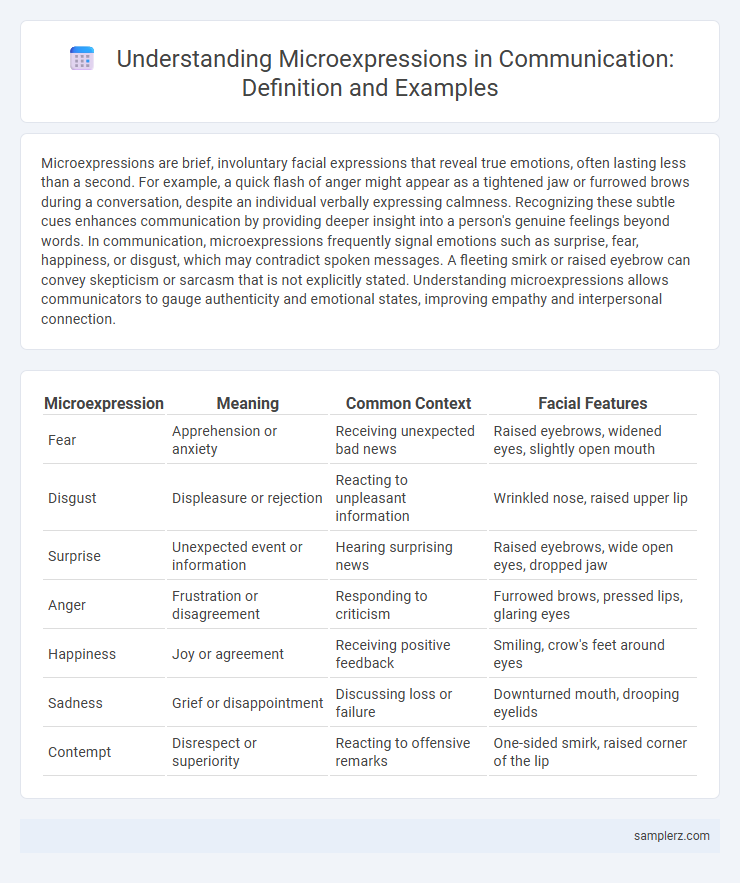Microexpressions are brief, involuntary facial expressions that reveal true emotions, often lasting less than a second. For example, a quick flash of anger might appear as a tightened jaw or furrowed brows during a conversation, despite an individual verbally expressing calmness. Recognizing these subtle cues enhances communication by providing deeper insight into a person's genuine feelings beyond words. In communication, microexpressions frequently signal emotions such as surprise, fear, happiness, or disgust, which may contradict spoken messages. A fleeting smirk or raised eyebrow can convey skepticism or sarcasm that is not explicitly stated. Understanding microexpressions allows communicators to gauge authenticity and emotional states, improving empathy and interpersonal connection.
Table of Comparison
| Microexpression | Meaning | Common Context | Facial Features |
|---|---|---|---|
| Fear | Apprehension or anxiety | Receiving unexpected bad news | Raised eyebrows, widened eyes, slightly open mouth |
| Disgust | Displeasure or rejection | Reacting to unpleasant information | Wrinkled nose, raised upper lip |
| Surprise | Unexpected event or information | Hearing surprising news | Raised eyebrows, wide open eyes, dropped jaw |
| Anger | Frustration or disagreement | Responding to criticism | Furrowed brows, pressed lips, glaring eyes |
| Happiness | Joy or agreement | Receiving positive feedback | Smiling, crow's feet around eyes |
| Sadness | Grief or disappointment | Discussing loss or failure | Downturned mouth, drooping eyelids |
| Contempt | Disrespect or superiority | Reacting to offensive remarks | One-sided smirk, raised corner of the lip |
Understanding Microexpressions in Communication
Microexpressions such as brief eyebrow raises, subtle lip presses, or fleeting eye twitches reveal concealed emotions that often contradict spoken words, enhancing the accuracy of interpersonal communication. Recognizing these involuntary facial cues enables individuals to detect deception, empathy, and emotional states, fostering deeper understanding and trust in conversations. Research by psychologist Paul Ekman emphasizes that mastering microexpression awareness improves conflict resolution and negotiation outcomes by uncovering true feelings beneath verbal exchanges.
Key Microexpressions and Their Meanings
Key microexpressions in communication include a fleeting frown indicating confusion or disagreement, brief lip presses signaling discomfort or anxiety, and quick eyebrow raises expressing surprise or skepticism. Recognizing these subtle facial cues enhances understanding of unspoken emotions and intentions during conversations. Mastering the identification of microexpressions supports more effective interpersonal communication and emotional intelligence.
Importance of Microexpressions in Effective Communication
Microexpressions, such as a fleeting frown or a quick smile, reveal genuine emotions that can't be easily controlled, offering critical insights during communication. Recognizing these subtle facial cues enhances empathy, trust-building, and conflict resolution by allowing individuals to respond more authentically and appropriately. Mastery of microexpression interpretation improves interpersonal interactions and facilitates clearer, more effective communication in both personal and professional settings.
Fear Microexpression: Recognizing Hidden Anxiety
Fear microexpressions often manifest as widened eyes, raised eyebrows, and slightly open mouth, signaling hidden anxiety in communication. These fleeting facial cues typically last less than a second, revealing an unconscious emotional response before conscious control takes over. Recognizing these subtle expressions can improve interpersonal understanding and help identify underlying fear or discomfort during conversations.
The Role of Surprise in Nonverbal Communication
Surprise often manifests through microexpressions such as raised eyebrows, wide-open eyes, and a dropped jaw, signaling sudden awareness or unexpected information. These fleeting facial cues typically last less than half a second but provide a powerful, authentic insight into an individual's immediate emotional state. In communication, recognizing surprise microexpressions enhances empathetic engagement and helps decode unspoken reactions during conversations.
Detecting Contempt in Professional Interactions
Detecting contempt in professional interactions often involves recognizing subtle microexpressions such as a slight sneer, tightened lips, or a brief upward movement of one corner of the mouth. These fleeting facial cues, usually lasting less than half a second, can reveal hidden feelings of disrespect or disdain despite polite verbal exchanges. Understanding these microexpressions enhances emotional intelligence and improves conflict resolution in workplace communication.
Identifying Anger through Facial Microexpressions
Identifying anger through facial microexpressions involves observing brief, involuntary muscle movements such as furrowed brows, tightened lips, and flared nostrils. These microexpressions typically last less than half a second and reveal genuine emotional reactions despite attempts to conceal them. Recognizing these subtle cues enhances effective communication by allowing a better understanding of underlying frustration or hostility.
Microexpressions of Happiness and Authenticity
Microexpressions of happiness often include a genuine Duchenne smile, characterized by the upward movement of both the mouth and the muscles around the eyes, signaling authentic positive emotions. In communication, these microexpressions convey sincerity and build trust, enhancing interpersonal connections. Detecting authentic smiles versus forced ones is crucial for interpreting true emotional states and improving empathetic engagement.
Microexpression Detection in Cross-Cultural Communication
Microexpression detection plays a crucial role in cross-cultural communication by revealing true emotions despite language barriers. For instance, a brief, involuntary facial expression of surprise or discomfort may indicate misunderstanding or disagreement even when words convey politeness. Recognizing these subtle cues enhances empathetic interactions and reduces misinterpretations between individuals from diverse cultural backgrounds.
Practical Applications of Microexpression Awareness
Recognizing microexpressions, such as a fleeting frown or brief lip twitch, enhances communication accuracy by revealing true emotions beneath spoken words. Training in microexpression awareness enables negotiators, therapists, and law enforcement officers to detect deception, build trust, and respond empathetically. Practical use of microexpression interpretation improves emotional intelligence and interpersonal effectiveness in high-stakes interactions.

example of microexpression in communication Infographic
 samplerz.com
samplerz.com